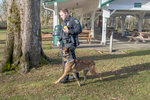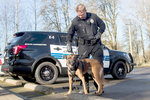

For police K9 handlers, their dogs are more than a tool to help find suspects or drugs — they’re a full-time partner, company on long shifts and “instant backup,” said Chehalis officer Warren Ayers.
“It’s a security blanket. I always have somebody there and know what’s going to happen,” he said.
“Long nights, you have someone to talk to,” he added.
However, Ayers and Centralia Police Officer Ruben Ramirez both lost their security blankets suddenly this summer. Ayer’s dog Reign died on duty in June after a still-unexplained medical event, and Ramirez’s K9 partner Lobo was retired in September after developing a spinal injury.
But the officers weren’t on the road alone for long. Ayers and Ramirez met their new partners — Tiesto and Pax, both male Belgian malinois dogs bred in Europe — last month, and for the past four weeks they’ve been training hard, bonding along the way.
“It’s different for everyone,” Ramirez said. “He’s a lot younger dog than I’m used to, so you’re going through the puppy pains. Because he’s a young dog, he’s still got a lot of maturing to do,” he said.
He described the dog as friendly, lovable and calm.
Ayers said nothing will help him get over the unexpected loss of Reign, but he said getting the new dog and going through training has proven that he’s meant to be a K9 handler.
“He’s a lot calmer than Reign was,” Ayers said. “Reign was a bull in a China shop.”
Pax and Ramirez and Tiesto and Ayers are participating in a six-week academy led by Carl and Jan Nielsen, of Code 4 Canine LLC, and are planning to take tests next week to become certified K9 units in Washington.
Carl Nielsen is Centralia’s police chief and trains dogs in his personal capacity.
A third dog and handler — German shepherd Bagira and Mill Creek officer Nathan Lerma — are training with the Lewis County officers. Lerma is a first-time handler and will have to complete a 10-week academy. He is staying in Centralia during the training.
Lewis County lost two-thirds of its K9 teams back to back earlier this year with the sudden loss of Reign and retirement of Lobo, leaving a hole in the county’s ability to track suspects and drugs. The departments decided this fall to work together to train two new dogs, purchased with donations from the community.
The Nielsens recently traveled to Europe to pick out the new dogs to train. Police dogs of European lineage are typically healthier and better adapted to working, Carl Nielsen told The Chronicle earlier this year.
They went with the goal of picking out the best dogs they could find. The selection process is rigorous, Jan Nielsen said.
The first test is sociability, she said. The dogs have to be friendly and outgoing to people and non-aggressive to other dogs.
“We have to be able to put our hands all over the dog,” she said.
If a touch to the ears, tail or feet is met with a bark or growl, the dog is rejected, she said.
That being said, the dogs also have to be willing to fight if provoked and must have a drive to hunt for toys.
“Then we look at the dog’s bite work,” she said.
An ideal dog is aggressive when it needs to be but not “angry,” she said.
“The dog has to take all of those checked boxes or they’re out,” she said.
The Nielsens brought home Pax and Bagira along with two more dogs from their most recent trip to Europe. They acquired Tiesto, a year older than the other dogs, in a recent trip and held onto him themselves until an agency was ready for him.
“These dogs are bred for working,” Nielsen said. “They have a microchip that’s already there.”
All three of the dogs participating in the Nielsens’ current training regimen are male, as are most police dogs.
The best female dogs are often kept out for breeding purposes, and most don’t make the cut when it comes to having the necessary fight, she said.
The three handlers met their dogs for the first time a month ago when they began training. The dogs have been trained for bite work, Nielsen said, but had little other training at the time.
“These are all considered green dogs,” she said.
They practice all day, five days a week on obedience on- and off-leash, scent tracking, bite work and agility training. The agility training builds the dogs’ confidence, Nielsen said.
“Everyday is an everything day,” she said.
After the dogs pass their certification with the Criminal Justice Training Commission, they’ll wait about six months before training them to sniff out drugs, she said.
A bottle of liquid “human scent” helps train the dogs to track possible suspects. One officer uses it to lay a scent trail before another follows.
“In training, we don’t make it unpredictable,” Nielsen said. “Right now we’re teaching the dogs what to do with their nose.”
Nielsen has been training police dogs since she was a handler herself in 1987.
Some dogs track every footprint and others skip ahead. Some dogs sit or lie down to show they’ve found a scent trail and others signal their success in other ways. However the dog does it, the result is what’s important.
“I want the dog to get from point A to point B using all his physical abilities,” she said.
With every successful track and obedience exercise, the dogs are rewarded with their favorite toy and an affectionate pat from their handler.
All dogs are different, so Nielsen trains them based on their individual personalities and needs.
The training is also for the handlers, who must also pass a the K9 certification.
“All of police work is a team effort when you have a dog,” Nielsen said.